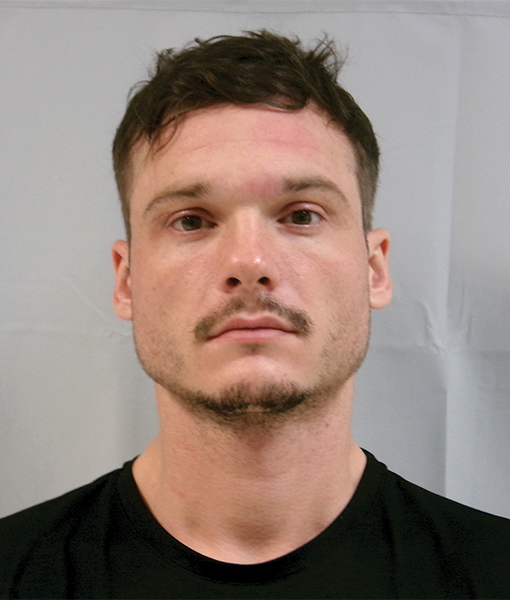Probable cause found in hearing

Jones
ELKINS — Probable cause was found Monday in the case of the former pastor of the Summit Church in Elkins, regarding a felony charge of distribution and exhibiting of material depicting minors engaged in sexually explicit activity.
The charge will now proceed to the grand jury, after Monday’s ruling by Randolph County Magistrate Michael Dyer.
Kevin Curtis Jones, 33, appeared in an orange prisoner’s jumpsuit in Randolph County Magistrate Court Tuesday afternoon, represented by attorney James Hawkins Jr. Assistant Randolph County Prosecutor Leckta Poling represented the state.
Jones is also charged with one felony count of soliciting a minor via computer. Probable cause was found against Jones for that charge on Oct. 14.
Jones is currently being held at the Tygart Valley Regional Jail on two separate $50,000 cash-only bonds set by Magistrates Benjamin Shepler and Dyer.
At the hearing’s start, Hawkins brought forth a bond modification motion, asking for Jones’ bond to be reduced. Hawkins said he “emphatically” believed that the $50,000 cash-only bond for this single charge was “grossly unconstitutional.”
In her response, Poling remarked that she actually believed the bond was “not high enough.” Poling said she believed Jones was already proving he could not be trusted on bond, as he had reportedly continued to make contact with the alleged victim, allegedly saying he wants to have a relationship with both the alleged victim and his wife.
Poling then asked Dyer to add conditions to Jones’ bond for this charge, such as, if Jones were able to make bond, he should not be permitted to have contact with anyone under the age of 18, and that his access to electronic devices should be monitored. Poling made a similar motion that was approved by Dyer at Jones’ first preliminary hearing.
After finding probable cause during Monday’s hearing, Dyer approved Poling’s motion for bond conditions and denied Hawkins’ motion for bond modification.
During the hearing, Poling called Deputy and Task Force Officer D.A. Cale with the Barbour County Sheriff’s Office and the Mountain Region Drug And Violent Crime Task Force to testify before the court. Cale is the investigating officer in both of the cases against Jones.
Cale told the court that, when he issued the search warrant for digital evidence from Jones’ cellular devices, he obtained two cellular devices that belonged to Jones and two devices that belonged to the alleged victim.
When Poling began to ask Cale to describe what photos of minors were found on Jones’ devices, Hawkins objected and asked the prosecution to allow the defense to see the photo evidence. Poling replied that it is “not the state’s position to produce child pornography” and that it would be inappropriate to do so during an open court hearing. Dyer overruled Hawkins’ objection and stated that the photos would not be shown in the courtroom.
Cale went on to explain to the court that there were several photos of the alleged victim in their underwear and in a swimsuit. Cale stated that directly after the swimsuit photo there was a similar photo of the alleged victim seemingly “exposing” private parts.
The second, more graphic image is believed to be generated through the use of AI, as Cale explained that it appears “one image was used to create the other” and that both images had the same timestamps. The timestamps also showed that the images were taken and altered in March, months before the alleged victim’s 18th birthday.
When asked by Poling as to how he knew it was AI, Cale explained that AI-generated images appear more “hyper-realistic” and “over-processed,” and that the alleged victim has distinctive tattoos that the AI failed to replicate properly in the second image.
Poling then asked Cale if there was any evidence that Jones had distributed or shown the graphic image to anyone else. Cale said there was no evidence of either at this time. When Poling asked if there was evidence that Jones knew the image was on his phone, Cale said yes.
In his cross-examination, Hawkins asked if this charge was brought forth because of one image. Cale said yes. Hawkins questioned if Cale was investigating whether or not someone else had access to the cellular devices in Jones’ possession, to which Cale said he was “still reviewing the data.”
Hawkins asked Cale if the AI-generated image depicted the alleged victim performing a sexual act, to which Cale said no. Hawkins then listed several sexual acts, asking each time if the image depicted the alleged victim doing such a thing. Cale responded “no” each time and said the alleged victim was depicted as “standing.”
When asked by Hawkins if investigators knew the age of the AI-generated body was on the alleged victim in the photo, Cale said he did not know, but stated that “it’s a depiction” of the alleged victim that was generated from a real photo.
Hawkins asked Cale if he had told the alleged victim to not speak to Hawkins or an investigator Hawkins had hired. Cale said he did not.
In a series of follow-up questions, Poling asked Cale if any other nude photos were found on the devices in Jones’ possession, to which Cale said yes, but stated that investigators did not know the ages of the subjects in the photos at this time.
In her closing argument, Poling said that the state had clearly provided probable cause that Jones had been in possession of the graphic image.
In his closing argument, Hawkins stated that computer-generated child pornography had only recently been added to the West Virginia statute regarding the distribution and exhibiting of material depicting minors engaged in sexually explicit activity, and that this was done after the image of the alleged victim was created and put on a cellular device.
Hawkins also argued that the statute revolves around if the minor in the portrayal was “engaged in any sexually explicit conduct,” which Hawkins said was not the case given what Cale had testified to. Hawkins stated that just “standing” in an image is not sexually explicit conduct, and therefore there was not any sexually explicit conduct in the AI-generated image.
In response, Poling remarked that Hawkins “loves to read part of the statute.” Poling explained to the court that there was more to the statute than what Hawkins had read, as the statute states “any visual portrayal of a minor engaged in any sexually explicit conduct or computer-generated child pornography” is a felony. Poling highlighted “or computer-generated child pornography,” stating that was the basis for this case, as the AI-generated image is considered “computer-generated child pornography.”
She added that, even if the statute had only been updated to include AI-generated content recently, Jones had still been in possession of that image when he was arrested on Oct. 1, after the statute was changed.




